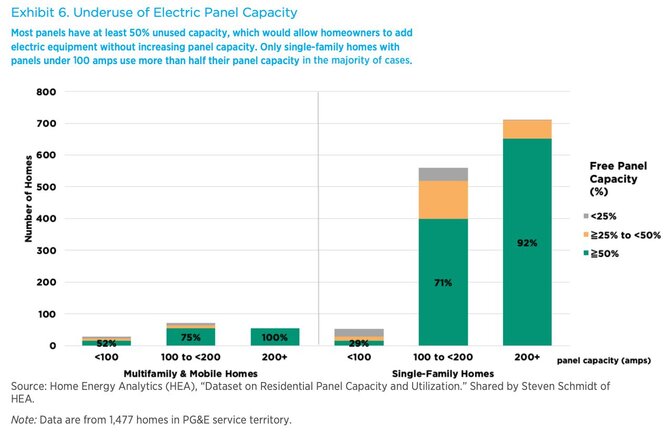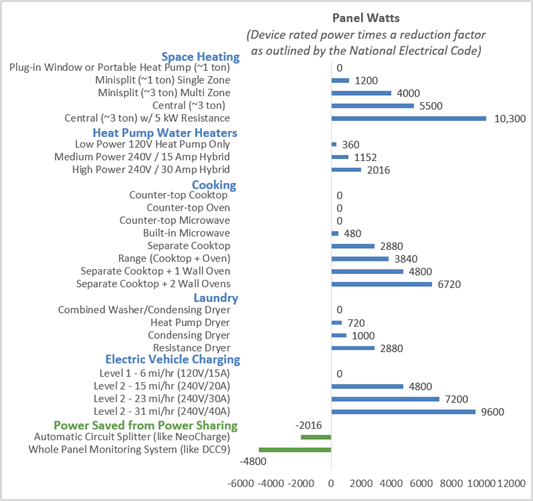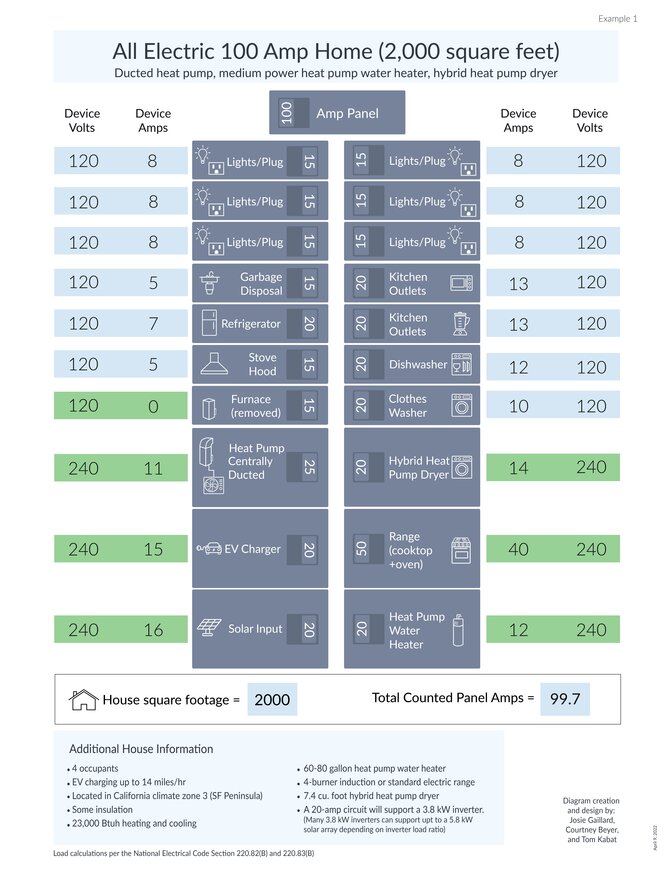Few thrills compare to the start of your electrification journey—choosing the best-rated heat pumps in your available budget; selecting the finishes on your top-choice induction range; daydreaming of the day you pay your very last gas bill.
But that excitement fades fast if you run into a surprising roadblock: your own electrical panel.
Adding capacity to a home's electric panel—also called a panel upgrade or panel upsizing—is often assumed to be necessary if you’re adding electric appliances or vehicles to your home. It makes sense, right? More electric devices means using more power, and using more power may mean needing a bigger electrical panel. But panel upgrades can be complicated and costly. They can also lead to even more expensive upgrades to service wires and utility poles, a process that public policy group SPUR describes as “confusing and expensive.”
The good news is that many of us can add heat pumps, heat pump water heaters, and electric devices to our heart’s content without upsizing our electrical panel.
Unless you love an unnecessary challenge, you probably want to avoid things that are confusing and expensive! The good news is that many of us can add heat pumps, heat pump water heaters, and electric devices to our heart’s content without upsizing our electrical panel. Here are three charts that break down why electrifying without a panel upgrade is not only possible, it’s likely preferable.
Here are three charts that break down why electrifying without a panel upgrade is not only possible, it’s likely preferable.
1. Many homes use less than half of their panel’s capacity.

This chart comes from SPUR, a Northern California-based policy nonprofit. Their 2024 report, Solving the Panel Puzzle, outlines the challenges of panel upgrades and suggests solutions.
Based on data from nearly 1,500 homes in California, this chart highlights how much panel capacity is currently unused. The bar on the far right represents single-family homes with panels of 200+ amps. This is a large panel, so it’s no surprise that 92% of homes use half of their panel or less.
But check out the second bar from the right. This represents single-family homes with 100- to 200-amp panels. A panel of 100 amps is more common among older homes, and this is where some start to feel the pinch of panel capacity. Yet among this group, 71% have half (or more) of their panel space unused.
Even homes with panels under 100 amps fare better than you might expect. A little less than a third still have 50% or more of their panel capacity available. That means these homes are good candidates to add a heat pump, a heat pump water heater, or possibly even both without upsizing their panel.
2. You can tidy up your watts.

So you’ve decided to electrify without upsizing your panel. In the words of energy engineer Tom Kabat: “Begin with the end in mind.” What do you want to replace and electrify? Your heating or HVAC system? Your water heater? Will there soon be an EV in your garage? Envision your ideal electric lifestyle. Then plan accordingly.
Envision your ideal electric lifestyle. Then plan accordingly.
This chart showcases the wattage demands of various household appliances. Seeing some of these bars is eye-opening. In my case, I realize right away: Despite my most earnest culinary ambitions, I really do not need a separate cooktop and two wall ovens. I do not need even one wall oven. A combined range with a cooktop and oven will do just fine. And with that simple decision, I have edited 2,880 watts out of my panel load.
The dryer catches my attention too. A resistance dryer uses almost three times more power than the next-best option. Why? Because it creates heat by forcing electricity through a resistant material, making electrons vibrate and warm up. Heat pump dryers work differently. They simply move heat from one place to another without wasting energy. This method is much more efficient and saves electricity, as this chart shows.
I like to think of this as “watt tidying.” Let’s call it a Marie Kondo, KonMari approach to my home’s panel: If it doesn’t spark efficiency, it’s out.
3. A sneak peek at a real-world panel.

Let’s take all of these charts out of the theoretical and ground them in the real. Here’s an example of a 100-amp panel serving a 2,000 square foot home.
As far as electrified homes go, it’s got the works. There is a heat pump HVAC system, a heat pump dryer, a heat pump water heater, and an EV charger. With some thoughtful watt editing, circuit curation, and precise appliance selection, all of these appliances come in at 99.7 amps on a 100-amp panel: no panel upsizing necessary.
So, how is this achieved? Here are four tips that may help you copy this well-curated panel.
- Go low and slow on EV charging. According to SPUR, most homeowners install Level 2 EV chargers that allow them to commute more than 100 miles a day. If that amount of miles sounds right to you, then you may need that big 50-amp, 240-volt dedicated circuit. Otherwise, pick a 15-amp, 240-volt circuit for Level 1 EV charging, which should give you all the charge you need overnight.
- Use multifunctional equipment to curate your circuits. A kitchen range that combines an oven and cooktop eliminates the need for a separate, high-power circuit for wall ovens. A combined washer and condensing dryer removes the need for a separate circuit for a dryer.
- Insulate and air-seal. Weatherization is the wind beneath the wings of building electrification (well, as long as that wind stays outside the home where it belongs). You’ll use far less power if your HVAC systems are heating and cooling efficiently without air leakage.
- Suit up your circuits with devices like smart panels, circuit splitters, circuit pausers, and meter socket adapters. These can nimbly manage your electrical load, preventing overdrawing on your panel’s capacity.
Even for a home with a 100-amp panel, electrifying doesn’t need to mean calling in the (utility) artillery.
All of these charts suggest that, even for a home with a 100-amp panel, electrifying doesn’t need to mean calling in the (utility) artillery. Get to know your panel. Envision your electric lifestyle and make thoughtful choices. Tidy up your panel with smart devices, and edit your watts—and with this approach, your panel can likely handle the switch.
The best place to get started: our Contractor Finder. This search tool is a portal to professionals who can guide you through panel planning, equipment installations, and even rebate paperwork. Our Pro Network is curated with verified electrification experts who can provide tailored advice for your panel and your needs. Now go live an electric lifestyle—without spending more than you need to!